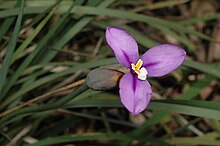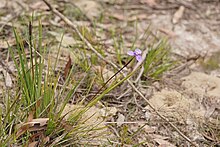Patersonia occidentalis, commonly known as purple flag,[2] or long purple-flag,[3] is a species of flowering plant in the family Iridaceae and is endemic to southern Australia. It is a tufted, rhizome-forming perennial with narrow, sharply-pointed, strap-like leaves, egg-shaped, bluish violet sepals and a cylindrical capsule. The Noongar name for the plant is komma.[4]
| Purple flag | |
|---|---|

| |
| Patersonia occidentalis in the ANBG | |
| Scientific classification | |
| Kingdom: | Plantae |
| Clade: | Tracheophytes |
| Clade: | Angiosperms |
| Clade: | Monocots |
| Order: | Asparagales |
| Family: | Iridaceae |
| Genus: | Patersonia |
| Species: | P. occidentalis
|
| Binomial name | |
| Patersonia occidentalis | |
| Synonyms[1] | |

Description
editPatersonia occidentalis is a tufted, rhizome-forming perennial that typically grows to a height of up to 1.5 m (4 ft 11 in). It has four to ten sharply-pointed, glabrous, strap-like leaves 80–550 mm (3.1–21.7 in) long and 2–10 mm (0.079–0.394 in) wide. The flowering scape is 10–80 mm (0.39–3.15 in) long with the sheath enclosing the flowers elliptic to lance-shaped, brown and 30–50 mm (1.2–2.0 in) long. The sepals are bluish-violet, 20–35 mm (0.79–1.38 in) long and 12–22 mm (0.47–0.87 in) wide, the petals are lance-shaped and the stamen filaments are 4–7 mm (0.16–0.28 in) long and joined together. Flowering mainly occurs from September to December, each flower open for one day, but each stem producing many flowers. The fruit is a cylindrical capsule 18–25 mm (0.71–0.98 in) long.[5][6][7]
Taxonomy
editPatersonia occidentalis was first formally described by the botanist Robert Brown in 1810 in his book Prodromus Florae Novae Hollandiae.[8][9] The specific epithet (occidentalis) means "western", referring to the distribution of this species compared to others in the genus Patersonia.[10]
The names of three varieties of P. occidentalis are accepted by the Australian Plant Census:
- Patersonia occidentalis var. angustifolia Benth.[11] grows in winter-wet areas, swamps and along river banks in the Jarrah Forest, Swan Coastal Plain and Warren biogeographic regions of western Australia;[12]
- Patersonia occidentalis var. latifolia Benth.[13] grows in upland flats, slopes and valleys in the Avon Wheatbelt, Esperance Plains, Geraldton Sandplains, Jarrah Forest, Swan Coastal Plain and Warren biogeographic regions of Western Australia;[14]
- Patersonia occidentalis R.Br. var. occidentalis[15] is the most widely distributed variety, occurring in Western Australia, South Australia, Victoria and Tasmania.[5]
Distribution and habitat
editPurple flag occurs in Western Australia, South Australia, Victoria and Tasmania. In Western Australia it grows in winter-wet areas, on sand dunes and around granite outcrops and is widespread and common between the Murchison River in the north and Israelite Bay in the south. In South Australia P. occidentalis grows in heath and in clearings, usually in poorly-drained sites and is only found in the south-east of the state. In Victoria the species is widespread in near-coastal areas on poorly-drained sites and in Tasmania it forms clumps in swampy places in the north and east of the state.[2][5][6][7][16]
Use in horticulture
editCultivated in gardens the species is frost tolerant and able to cope in a dry position.[17][18]
References
edit- ^ a b "Patersonia occidentalis". Australian Plant Census. Retrieved 3 November 2021.
- ^ a b "Patersonia occidentalis". FloraBase. Western Australian Government Department of Biodiversity, Conservation and Attractions.
- ^ Conn, Barry J.; Stajsic, Val. "Patersonia occidentalis". Royal Botanic Gardens Victoria. Retrieved 3 November 2021.
- ^ "Noongar names for plants". kippleonline.net. Archived from the original on 20 November 2016. Retrieved 12 December 2016.
- ^ a b c "Patersonia occidentalis". Australian Biological Resources Study, Department of Agriculture, Water and the Environment: Canberra. Retrieved 3 November 2021.
- ^ a b Messina, Andre; Stajsic, Val. "Patersonia occidentalis var. occidentalis". Royal Botanic Gardens Victoria. Retrieved 3 November 2021.
- ^ a b "Patersonia occidentalis". State Herbarium of South Australia. Retrieved 3 November 2021.
- ^ "Patersonia occidentalis". APNI. Retrieved 3 November 2020.
- ^ Brown, Robert (1810). Prodromus Florae Novae Hollandiae. London. p. 304. Retrieved 3 November 2021.
- ^ Sharr, Francis Aubi; George, Alex (2019). Western Australian Plant Names and Their Meanings (3rd ed.). Kardinya, WA: Four Gables Press. p. 264. ISBN 9780958034180.
- ^ "Patersonia occidentalis var. angustifolia". Australian Plant Census. Retrieved 3 November 2021.
- ^ "Patersonia occidentalis var. angustifolia". FloraBase. Western Australian Government Department of Biodiversity, Conservation and Attractions.
- ^ "Patersonia occidentalis var. latifolia". Australian Plant Census. Retrieved 3 November 2021.
- ^ "Patersonia occidentalis var. latifolia". FloraBase. Western Australian Government Department of Biodiversity, Conservation and Attractions.
- ^ "Patersonia occidentalis var. occidentalis". Australian Plant Census. Retrieved 3 November 2021.
- ^ Jordan, Greg. "Patersonia occidentalis". University of Tasmania. Retrieved 3 November 2021.
- ^ "Patersonia species Native Iris or Native Flag". Australian National Botanic Gardens. 2012. Retrieved 12 December 2016.
- ^ "Patersonia occidentalis". Government of Western Australia, Botanic Gardens and Parks Authority. Retrieved 3 November 2021.